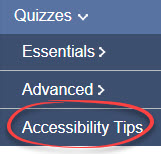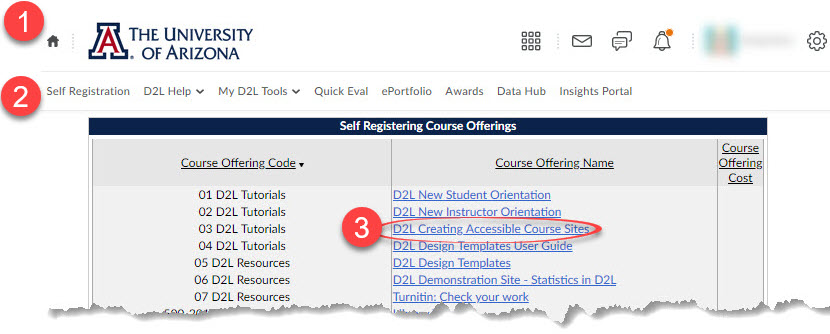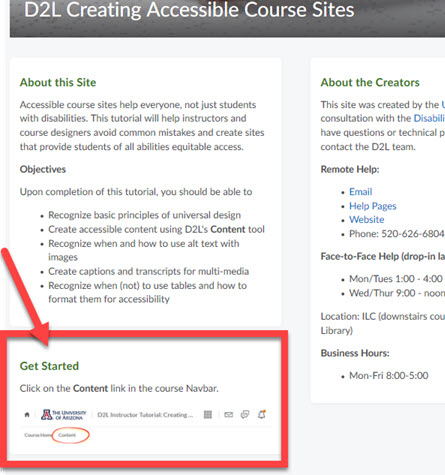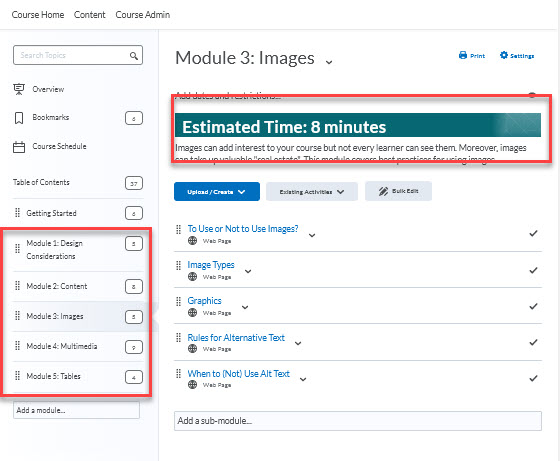1. About: Accessible Design
Accessible design helps everyone, not just students with disabilities.
Here are some examples:
- Captions that help language learners better understand complex text
- Video transcripts that are printed and used to take notes
- Audio versions that busy students listen to on their way to work
Note: Check out the University of Arizona Disability Resource Center (DRC) website for a deeper dive into the seven principles of Universal Design.
As the above examples demonstrate, accommodations intended for people with disabilities make your content more inclusive for all students. Following principles of Universal Design for Learning (UDL), they offer
- Flexibility in use
- Provide information that is perceptible in different ambient environments
- Create content that can be used efficiently
Learn More
Look for accessibility tips throughout these help pages.

Learn More
Visit the Disability Resource Center's webpage on IT accessibility.
Learn More
Take a self-paced tutorial on accessible course design. In D2L,
- Click the Home icon
- Click the Self Registration tab in the Navbar
- Select the D2L Creating Accessible Course Sites offering and follow the prompts

2. Strategy: Consistent Organization
Carefully consider how you organize the content you add to your site.
D2L is designed to give your site a consistent structure. You, however, control the organization of the materials you add.
Note: With a consistent design, students will spend less time looking for information and more time learning.
Who this helps:
- People using screen magnification who can only see a portion of the screen at any time
- People with cognitive and learning disabilities who need consistency to be able to orient themselves
- People using screen-reading software
Who this also helps:
- People who are new to D2L
- People who are not confident using computers
- People who access their courses using phones and other devices with small screens
- Everyone, who can more easily find what they need
Strategy
Provide clear instructions for moving around your course site.

Strategy
Make sure your instructions match the hover text (what you see when you hover your mouse over an element in the course), since blind and low vision students use these labels to navigate.

Strategy
Any action should always result in the same reaction (for example, all links open in a new window, Content modules all include descriptions and estimated times to complete).

3. Strategy: Design for Difference
Build flexibility into your course.
Assume students have a wide range of skills, abilities, experiences, and personal situations. Flexibility helps by giving students choices about how and when to access learning. This may be as simple as providing videos and transcripts (multiple ways of accessing the same content) or as complex as self-guided course materials (allowing students to work at their own pace).
Who this helps?
- People with different learning styles
- People with cognitive impairments who need more time to learn and practice
- People who use assistive technology and may find some formats easier than others to access
Who this also helps?
- People in different time zones who may access content at different times
- People with busy schedules who may need to work at odd hours
- People in noisy environments who may not be able to listen to something, but can read it
- People who may prefer to listen to content while driving children to school or working out
- Everyone, since most people will experience a temporary disability at some point in our lives
Strategy
Assume a wide-range of language skills. Define all jargon and acronyms. Add links to definitions and resources for students who may need more information to grasp a concept.
Strategy
Caption or provide transcripts for all audio and video.

Videos are required to have captioning on them at the UA, which is great for a variety of students, allowing them to access the material anywhere (even in noisy or busy areas). You can also create a transcript of the video, which can be available as a link in D2L.
Strategy
Create a note-taking system.
Some students may need note-takers as a way to access course material. Instead of forcing these students to self-identify, you can upload your own notes to D2L, create a system to share the work of note-taking (for example, you can create a discussion topic and allow anonymous posts), or provide students incomplete notes (skeleton outline) to fill in during class time.
Strategy
Record synchronous meetings and allow students to access them later. Build in ways of ensuring students have equivalent learning experiences.
For example, set your Zoom recordings to save to Panopto. At the place where you prompt students to answer a question during the synchronous meeting, use Panopto to insert a quiz question into the video recording. Or, if you use breakout rooms, tell students watching the recording to pause the video and participate in a discussion you have built into D2L. Note: you can edit out of the video the time you are in breakout rooms or simply pause the recording and start it again once the break out rooms are concluded.
Strategy
Set up a Checklist that learners can use to obtain extra resources, help, or course materials in a different format.
For example, for each week or major assignment, create checklist items that include text-only versions of the course material, an extra help discussion forum, additional reading material, and alternative formats for multimedia material. Set Release Conditions for the checklist items so the requested content is automatically released to those who need it. This option ensures that the majority of learners access the material as you intended, but learners' needs are supported.
4. Strategy: Offer Choices
Give learners choices about how to learn and demonstrate their knowledge.
Who this helps:
- Disabled people who may not be able to access materials the same way other students do
- People with invisible disabilities who may not want to self-identify as needing accomodations
Who this also helps:
- People with different learning styles
- People with time and other constraints who may find some formats more helpful than others
- People with a wide variety of experiences and skills they can bring to the course activities
Strategy
Think carefully about images. When you insert an image into D2L, make sure the substance of the image is described in text or in alt text.
Strategy
Provide alternative formats for activities. For example, if you use slides, make sure the content on those slides can be seen and heard. If you provide links to online videos, make sure those videos have captions or transcripts. If you use a video lecture, do not turn away from the camera in case you have students who read lips.
Strategy
Use a variety of assessment types such as written, oral, and auto-graded. That way you do not favor students who do well with one assessment type but struggle with others. You can also give students options in choosing their testing format. Work with a D2L consultant to set this up in your grade book.
Strategy
If you have assignments, give students options. For example, you can allow them to choose a topic that fits their interest, or select a topic from list. You can also give them options in choosing the assignment format. For example, you might allow students to write an essay or produce a podcast or create a blog. When you create a D2L Assignment, students can submit text, video, audio, links, images and more.
Learn More
For more tips, read this blog on How to Teach for Accessibility.

